Hamachi and Kanpachi are both prized choices for sashimi, with Hamachi offering a richer, buttery flavor and a slightly softer texture ideal for those who enjoy a creamy taste. Kanpachi, on the other hand, provides a firmer texture and a cleaner, more delicate flavor that appeals to sashimi enthusiasts seeking a lighter bite. Selecting between Hamachi and Kanpachi ultimately depends on personal preference for flavor intensity and texture in sashimi dishes.
Table of Comparison
| Feature | Hamachi | Kanpachi |
|---|---|---|
| Species | Yellowtail Amberjack (Seriola quinqueradiata) | Greater Amberjack (Seriola dumerili) |
| Flavor | Rich, buttery, slightly sweet | Clean, mild, less oily |
| Texture | Soft, tender | Firm, slightly chewy |
| Color | Pale pink to light yellow | Light pink to off-white |
| Fat Content | Higher, richer mouthfeel | Lower, leaner cut |
| Common Use | Popular sashimi, sushi topping | Premium sashimi, sashimi platters |
| Season | Year-round, peak in winter | Year-round, peak in summer |
Introduction to Hamachi and Kanpachi Sashimi
Hamachi sashimi, derived from young yellowtail, boasts a rich, buttery texture and a slightly sweet flavor profile, making it a favorite among sushi enthusiasts. Kanpachi sashimi, sourced from greater amberjack, offers a firmer texture with a cleaner, more delicate taste that appeals to those seeking a lighter seafood experience. Both varieties provide distinct culinary experiences, with Hamachi focusing on richness and Kanpachi emphasizing subtlety in sashimi dishes.
Species Differences: Hamachi vs Kanpachi
Hamachi, also known as Japanese amberjack (Seriola quinqueradiata), is a species primarily farmed in Japan, prized for its rich, buttery texture and higher fat content, making it ideal for sashimi. Kanpachi, or greater amberjack (Seriola rivoliana), is typically wild-caught and features a leaner, firmer flesh with a mild, clean flavor distinguished from Hamachi's oiliness. The species differences influence texture and taste profiles, with Hamachi offering a creamy mouthfeel while Kanpachi provides a crisp bite preferred by sashimi connoisseurs seeking a lighter option.
Appearance and Color Comparison
Hamachi sashimi displays a pale pink to light yellow hue with a slightly translucent texture, characterized by its delicate marbling and subtle sheen. Kanpachi sashimi, in contrast, features a more vibrant, slightly orange-pink coloration with a firmer texture and a sharper, glossier surface. The visual differences in color and texture between Hamachi and Kanpachi are key indicators for chefs and connoisseurs distinguishing freshness and flavor profile in sashimi presentation.
Taste Profiles: Subtle Nuances
Hamachi sashimi offers a rich, buttery flavor with a slightly sweet finish, characterized by its tender, oily texture that melts in the mouth. Kanpachi presents a cleaner, crisper taste with a firmer bite and a subtle briny note, emphasizing freshness and balance. The subtle nuances between Hamachi and Kanpachi cater to different palates, with Hamachi favoring richness and Kanpachi delivering a refreshing, delicate experience.
Texture and Mouthfeel Analysis
Hamachi sashimi offers a buttery, rich texture characterized by a creamy mouthfeel and moderate fattiness, creating a melt-in-the-mouth experience. Kanpachi presents a slightly firmer, denser texture with a clean, crisp bite and less oiliness, providing a refreshing contrast to Hamachi. Texture-wise, Hamachi delivers a softer, more velvety sensation while Kanpachi is known for its resilience and chew, making it ideal for those who prefer a meatier sashimi option.
Nutritional Value: Health Benefits
Hamachi sashimi offers higher omega-3 fatty acids, promoting heart health and reducing inflammation, while Kanpachi provides a leaner protein source with lower calorie content. Both fish are rich in essential vitamins like B12 and minerals such as selenium, supporting brain function and immune defense. Choosing Hamachi or Kanpachi for sashimi depends on whether one prioritizes healthy fats or a lighter nutritional profile.
Sourcing and Sustainability Considerations
Hamachi sashimi, sourced primarily from yellowtail species farmed in Japan and the Pacific, benefits from more established aquaculture practices that emphasize controlled environments and reduced wild stock depletion. Kanpachi, often wild-caught or farmed in offshore pens in Hawaii and Southeast Asia, faces sustainability challenges due to less standardized farming methods and potential overfishing risks. Evaluating sashimi options through sourcing transparency and adherence to eco-certifications like MSC or ASC helps ensure environmentally responsible consumption.
Preparation Techniques for Sashimi
Hamachi sashimi requires careful slicing against the grain to maximize its buttery texture and highlight its rich, fatty flavor, often served slightly thicker to emphasize mouthfeel. Kanpachi, known for its firmer, leaner flesh, benefits from precise, thinner cuts that accentuate its clean, delicate taste and smooth consistency. Both fishes demand freshness and sharp blades to preserve their integrity and deliver the optimal sashimi experience.
Pairing with Sauces and Sides
Hamachi sashimi, known for its rich, buttery texture, pairs exceptionally well with citrus-based sauces like ponzu that balance its fattiness and enhance its umami flavor. Kanpachi sashimi offers a leaner, firmer bite that complements spicier accompaniments such as wasabi or yuzu kosho, providing a zesty contrast to its mild sweetness. Common sides like pickled ginger and daikon radish cleanse the palate and elevate the tasting experience for both types of sashimi.
Expert Recommendations: Which to Choose?
Experts recommend choosing Hamachi for sashimi when seeking a rich, buttery flavor with a tender texture, ideal for traditional preparation styles. Kanpachi offers a milder taste and firmer bite, preferred by chefs aiming for a balanced and slightly less fatty sashimi experience. Culinary professionals often suggest selecting based on personal preference for flavor intensity and texture, with Hamachi noted for its higher fat content contributing to a luxurious mouthfeel.
Hamachi vs Kanpachi for Sashimi Infographic

 cookingyes.com
cookingyes.com